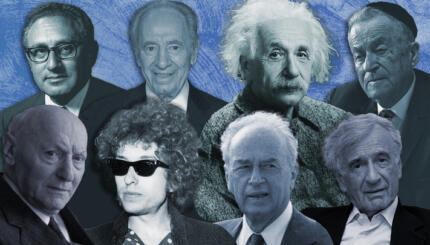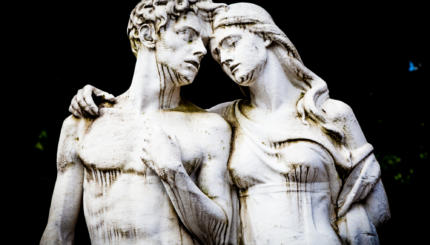Reprinted with permission from Rock ‘N’ Roll Jews (Five Leaves Publications).
There is a hidden story about the central Jewish contribution [to rock music] waiting to be told. This is not a story of uncovering forgotten Jewish ancestors. There will be no revelations that Elvis or Little Richard had Jewish great-great-grandmothers. Even if such ancestry could be found, it would hardly be significant. After all, rock’n’roll was not created by forgotten, long dead, great-great-grandmothers.
Jews Behind the Scenes
Nor will the story of the overlooked Jewish contribution depend upon a trawl through rock’s minor celebrities. In fact, the blank sheet could be partially filled with a respectable collection of reasonably well-known names. There could be Marc Bolan, Manfred Mann and Peter Green, who was Fleetwood Mac’s original, and arguably most talented, guitarist. We could then move forward to take in the Beastie Boys and Ian Broudie of the Lightning Seeds. And so on. But the resulting compilation would not be a premier division list. It would lack the founding performers–the Elvises, the Jerry Lees, the Chucks, not to mention the John, Paul, George, and Ringos.
However, searching for Jewish band-members from the early days to the present would not be the way to document the immense Jewish contribution to rock. In fact, if one concentrated upon the public performers, one would almost entirely miss the core of the Jewish contribution. At least in rock’s early days, that contribution lay behind the scenes, largely hidden from the public gaze.

Help us keep Jewish knowledge accessible to millions of people around the world.
Your donation to My Jewish Learning fuels endless journeys of Jewish discovery. With your help, My Jewish Learning can continue to provide nonstop opportunities for learning, connection and growth.
Of course, managers and impresarios operate behind the scenes. In the world of show business, there have been Jewish managers aplenty. In fact, the very word “rock’n’roll” itself was the creation of rock’s earliest and most famous promoter, Alan Freed. It is said that he even tried to copyright the term. However, a history of rock’s Jewish contribution which concentrated on management would tend to confirm the blank sheet of paper. The contribution would not be a creative one, but one which facilitates the creativity of others, who would be the real heroes of rock’s story. Indeed, even Freed’s claim to have linguistically invented “rock’n’roll” has been disputed.
The Creative Element
There is, however, a contribution which is both behind-the-scenes and also highly creative. When thinking of classic rock’n’roll, it is easy just to think of the performers–to imagine Elvis in his gold suit, or Jerry Lee, pounding the piano with his hair flopping forward. What can be forgotten is that these performers often did not write their own songs.
Moreover, the young rock fans were principally linked to the stars, not by public performances, but by records. Millions, who had never seen Elvis perform, could buy his records. For the average teenager, this was the way to be a fan. Elvis’s records, and those of the other rock stars, sounded different from anything that the previous generation had ever listened to. The whine of the electric guitar, the crisp drumming, the echo effects, and, later, more complex mixtures of electric and acoustic instruments all made rock’n’roll a new sound. This was modern music, made in a modern way.
Someone had to write the songs. Someone had to create the sounds. If Elvis didn’t compose his own words and music, then he certainly didn’t produce his own records. Who were these hidden composers? Who were the behind-the-scenes producers who crafted the new ways of creating music?
Once these questions are asked, then the Jewish names come tumbling out. Names such as Jerry Leiber, Mike Stoller, Doc Pomus, Jerry Wexler, Jerry Ragovoy, and Phil Spector–these are the real heroes. Rock fans will know songs like “Hound Dog,” “Jailhouse Rock,” “Save The Last Dance For Me,” “You’ve Lost That Lovin’ Feelin,” “Sweets For My Sweet,” and many, many more.
For a whole generation, such songs marked the times in which they grew up. The music was part of life and the sounds continue to haunt the memory. Years later the songs are instantly recognizable, often from the first bar, even the first note, of the classic recording. You only have to hear Elvis start to sing unaccompanied “You ain’t” to know that “nothing but a hound dog” is to follow.
Yet how many people, who grew up in the Fifties or Sixties, would be able to name the composers? More to the point, how many young Jewish boys or girls who listened to such music, often with severe parental disapproval, would know that, in a literal sense, they were hearing “Jewish music”?
Dylan, Simon, Reed, & Cohen
The Jewish contribution does not end there. The early history of rock can be divided into two periods of roughly 10 years each. It would be easiest to label these periods the music of the Fifties and that of the Sixties. But, strictly speaking, that would be inaccurate. During the first part of the fifties, the music of the Forties was still going strong. Rock’n’roll did not make its rude entrance until the mid-Fifties. The first period lasted from about 1955 to 1965. This was the period when the Jewish songwriters and producers made their greatest and most innovative contributions. At first, this contribution was to be found with the sounds of classic rock and rhythm and blues. Then it softened into lighter, poppier songs, as strings were used to complement the electric guitars.
The second period starts with the rise of the Beatles and the Stones. This is the music of the Sixties, although, musically speaking, “Sixties music” did not really get going until about 1964. This was a time of change and protest, which made the Fifties, by contrast, seem nostalgically quiet. Fashions altered dramatically: Boys’ hair grew longer in the Sixties while girls’ skirts shortened. Freedom and rebellion were in the air. Illegal substances were smoked. Taboos were publicly broken. There were large-scale demonstrations against authority, including, of course, mass political demonstrations against the Vietnam war, against the running of universities, and against racist segregation in the south of the United States.
Not surprisingly in a time of political and cultural change, the sounds of pop music developed. In this new era, the back-room composers lost their supreme niche as so many of the new singers were writing their own material. Indeed they were expected to do so. Pop was changing. A more educated, middle-class type of person was beginning to use rock as a means of expression. More complex, even poetic, lyrics were being written. Here again, there was a solid Jewish contribution. Foremost among the singer-songwriters of this era we find Bob Dylan, Paul Simon, Lou Reed, and Leonard Cohen–all raised as Jews and all, indelibly, leaving a mark on their times.
What counts in all this are numbers. One notable figure proves little. The fact that Bob Dylan was Jewish does not in itself suggest anything about the relations between Jews and popular music. But the fact that Paul Simon, Lou Reed, and Leonard Cohen’s names can also he added indicates that here might be something of more historical and cultural significance. It is the same with the names of composers and producers of rock’s first decade.
One Jew writing hit songs might be of interest to family and the local Jewish press. Two Jews–and the professional anti-Semites start to get interested, suspecting a conspiracy. Three Jews–this might just be a sign of a wider cultural trend. In the case of rock’s early history, the numbers involved are well beyond the level of chance.


